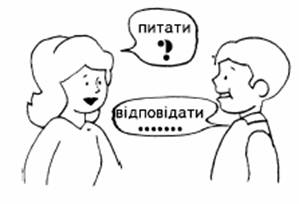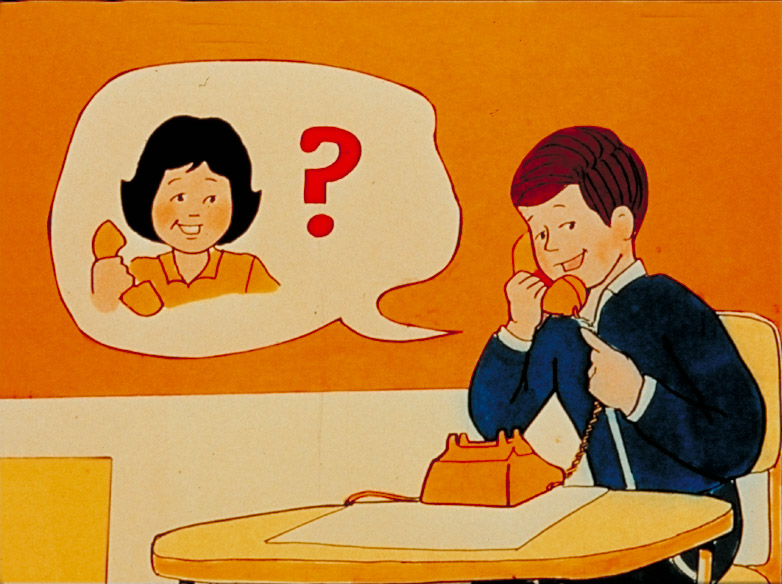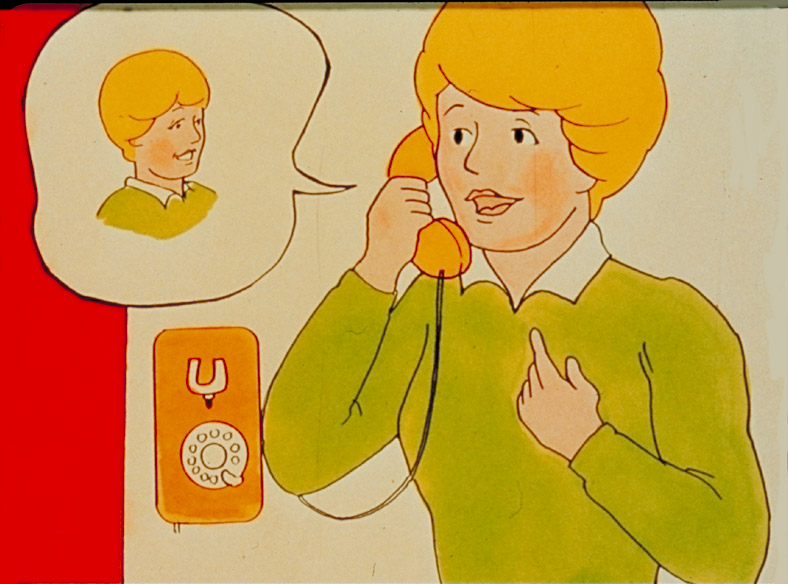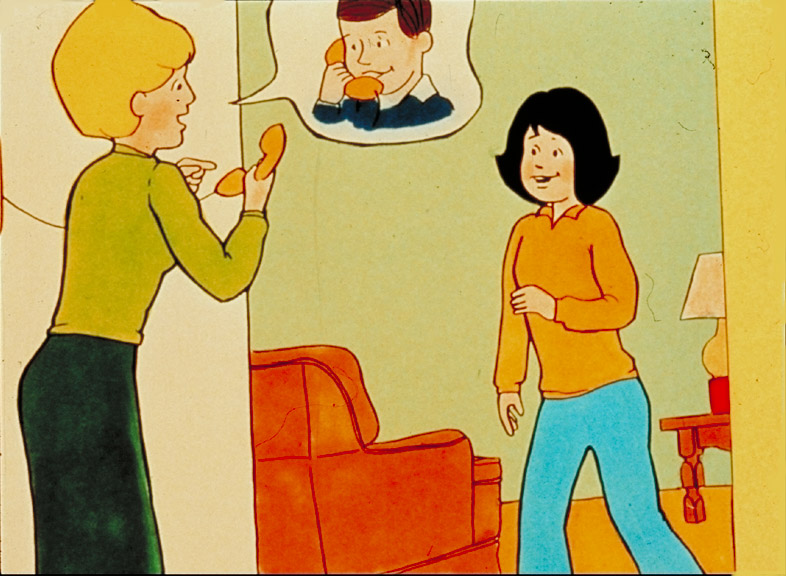
In Lesson 3 you will be introduced to some new information about verbs and pronouns. The lesson will contain the following information:
- Verbs – two new verbs in the Group I є-ють, е-уть verbs will be introduced, as well as a new verb in the Group II Conjugation.
- Pronouns – demonstrative pronouns are reviewed and expanded.
|
Дієслова:
І-а група
Verbs: Group 1 Conjugation |
The Group 1 є-ють verbs which you have now learned are: читати, мати, грати, питати, слухати.
In Unit VII you are introduced to two new verbs belonging to this group:
телефонувати (to telephone)
відповідати (to respond/answer)
Телефонувати
In Group I, most verbs are conjugated by dropping the infinitive ending ти, and adding the appropriate verb endings. However, verbs ending in ‘вати’ follow a slightly different pattern in which the last two syllables ва - ти are dropped. If we look at the verb телефонувати, the stem телефону takes on the appropriate endings, as shown below.
| singular |
|
plural |
| |
|
|
| я телефону + ю |
|
ми телефону + ємо |
| ти телефону + єш |
|
ви телефону + єте |
| він, вона, воно телефону + є |
|
вони телефону + ють |
As with the verb писати, either the Genitive Case plus the preposition до (to), or the Dative Case, may be used with this verb.
Genitive Case + preposition до:
До кого ти телефонуєш? Я телефоную до Оксани.
Dative Case without a preposition:
Кому ти телефонуєш? Я телефоную Оксані.
VI. Exercise 3.i
Complete the exercise below by inserting the correct form of the verb телефонувати. Find the nouns which appear in the Genitive case or the Dative Case, identify above the word which case is used, and write the Nominative form in the space on the right. An example is given.
Genitive
- Коли ти телефонуєш до Наталки? Наталка
- Коли ви ______________ мамі? ___________
- Дмитро __________________ до Тараса. ___________
- Чи пані Тріщук ________________ Лесі? ___________
- Ні, вони не ________________ до діда . ___________
- Я _______________ вчительці сьогодні. ___________
- Ми тепер вдома і ______________ до тата. ___________
Відповідати
As with most verbs in Group I, the infinitive ending ти is dropped before adding the verb endings.
| singular |
|
plural |
| |
|
|
| я відповіда+ ю |
|
ми відповіда + ємо |
| ти відповіда + єш |
|
ви відповіда + єте |
| він, вона, воно відповіда + є |
|
вони відповіда + ють |

VII. Exercise 3.ii
відповідати |
___ |
відповідаю |
___ |
відповідаємо |
___ |
відповідаєш |
___ |
відповідаєте |
він |
відповідає |
___ |
відповідають |
|
|
|
|
1. |
Наталка питає , а я ____________________________. |
|
|
2. |
Хто ____________________________? |
|
|
3. |
Ми ____________________________. |
|
|
4. |
Галина й Борис ____________________________. |
|
|
5. |
Чи пан Жук ____________________________? |
|
|
6. |
Ні , пані Брик ____________________________. |
|
|
7. |
Можна ____________________________? Так , можна . |
|
|
8. |
Ви питаєте, а ми ____________________________. |
|
|
9. |
Вона ____________________________ тепер . |
|
|
10. |
Ти питаєш , але не ____________________________. |
|
|
|
Дієслова: 2 - а група
Verbs: Group 2 Conjugation |
As you already know, there are two verb conjugations (two verb groups) in Ukrainian. Group 1 Conjugation has two subgroups:
- є, ють (читати, мати, грати, питати, слухати, відповідати, телефонувати)
- е, уть (писати, жити, іти)
Group II Conjugation will be introduced in this Unit. Although this group also has subgroups, you will be introduced to only one verb, говорити (to talk) at this time. In order to conjugate this verb, we drop the infinitive ending ити and add appropriate verb endings. Note the pattern of conjugation below:
| singular |
|
plural |
| |
|
|
| я говор+ ю |
|
ми говор + имо |
| ти говор + иш |
|
ви говор + ите |
| він, вона, воно говор + ить |
|
вони говор + ять |
*It should be noted that the verb говорити may indicate that only one person is speaking. This verb does not indicate that a dialogue or conversation is taking place. For example: Мама говорить, а тато слухає!
VII. Exercise 3.iii
Conjugate the new verbs introduced in this unit by completing the exercise below.
| відповідати |
| вона, він |
____________________ |
_______ |
відповідаєш |
| я |
____________________ |
_______ |
відповідаємо |
| ми |
____________________ |
_______ |
відповідають |
| вони |
____________________ |
_______ |
відповідаю |
| ви |
____________________ |
_______ |
відповідає |
| ти |
____________________ |
_______ |
відповідаєте |
| говорити |
| вони |
____________________ |
_______ |
говоримо |
| ти |
____________________ |
_______ |
говорю |
| ми |
____________________ |
_______ |
говорять |
| він, вона |
____________________ |
_______ |
говориш |
| ви |
____________________ |
_______ |
говорить |
| я |
____________________ |
_______ |
говорите |
VII. Exercise 3.iv
Complete the exercise below as a review of all verb conjugations.
1. |
Я пиш___ до ______________________ (Оксана).
Я йд___ до ______________________ (Борис).
Я жив___ в ______________________ (Саскатун).
|
|
|
2. |
Ти пиш___ до ______________________ (Іван).
Ти йд___ до ______________________ (Наталка).
Ти жив___ y ______________________ (Торонто).
|
|
|
3. |
Він пиш___ до ______________________ (Галина).
Він ід___ до ______________________ (Богдан).
Він жив___ в ______________________ (Вінніпеґ).
|
|
|
4. |
Вона пиш___ до ______________________ (Іван).
Вона йд___ до ______________________ (Петро).
Вона жив___ в ______________________ (Едмонтон).
|
|
|
5. |
Ми пиш___ до ______________________ (Тарас).
Ми йд___ до ______________________ (Володимир).
Ми жив___ в ______________________ (Оттава).
|
|
|
6. |
Ви пиш___ до ______________________ (Одарка).
Ви йд___ до ______________________ (Ольга).
Ви жив___ в ______________________ (Ванкувер).
|
|
|
7. |
Вони пиш___ до ______________________ (тато).
Вони йд___ до ______________________ (мама).
Вони жив___ y ______________________ (Монреаль).
|
|
|
8. |
Ти говор___ з ______________________ (Марко).
Ми говор___ про ______________________ (Канада).
Я говор___ з ______________________ (Наталка).
|
|
|
9. |
Вона відповіда___, а він слуха___.
Ви відповіда___, а мама чита___.
Ми відповіда___, а вони пита___.
|
|
|
VII. Exercise 3.v
Complete the exercise as shown in the example, with appropriate forms of the verbs питати, відповідати.
- Пан Козак питає, а Тарас відповідає.
- Дівчата ________________, а хлопці _________________.
- Ви _________________, а ми _____________________.
- Я __________________, а ти _____________________.
- Хто __________________, а хто ___________________?
The Term ‘можна’
You will recall that you were introduced to the word можна in Dialogue 7. It is known as a modal verb because it is a form of the verb могти (to be able to, similar to the English I can/May I...?)
It is important to note that when the modal verb можна is used, the verb to which it refers is always in its infinitive form. You already know and remember that Ukrainian infinitives always end in ти.
Чи можна говорити з Оленкою?
|
 |
|
This structure (можна + verb infinitive) is very common in everyday Ukrainian conversations. It is recommended that you become familiar with its use.
VII. Exercise 3.vi
Read the sentences below aloud. Then rewrite the sentence using a different noun to replace the underlined noun. You will see the many functional uses of the structure:
можна + verb infinitive
- Чи можна читати журнал? Чи можна читати словник?
- Чи можна говорити з Романом? _______________________________
- Чи можна писати листа до діда? _______________________________
- Чи можна читати в четвер? _______________________________
- Чи можна йти на концерт? _______________________________
- Чи можна грати в бейсбол? _______________________________
- Чи можна говорити про Тамару? _______________________________
- Чи можна йти додому? _______________________________
- Чи можна телефонувати до Данила? _____________________________
- Чи можна відповідати тепер? _______________________________
The demonstrative pronoun це (this) is used to point out a particular individual (or object):
| Чи це Оленка? |
 |
|
| Ні, це пані Козак. |
 |
|
| Оленко, це Роман. |
 |
|
VII. Exercise 3.vii
Part A. Complete the exercise using the demonstrative pronoun це and the words given in parentheses. Practise reading the exercise aloud.
1. Чи це тато? (ні, пан Баран).
Ні, це пан Баран.
2. Чи це Марія й Таня? (ні, Марія й Даруся)
__________________________________
3. Чи це Одаркa? (ні, Тереса)
___________________________________
4. Чи це баскетбол? (ні, волейбол)
___________________________________
5. Чи це зошит? (ні, журнал)
___________________________________
Part B. Answer the question by choosing one of the names given. Practise reading the exercise aloud.
1. Хто це, Дмитро чи Давид? Це Давид.
2. Хто це, Тамара чи Тереса? ___________________________
3. Хто це, Соня чи Софія? ___________________________
4. Хто це, Степан чи Сергій? ___________________________
5. Хто це, Олена чи Одарка? ___________________________
|
|
|







